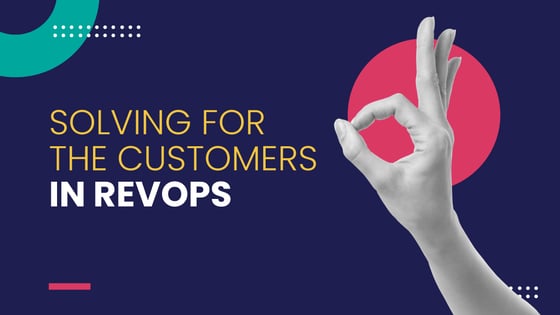






At its core, RevOps is about aligning your go-to-market teams around single goals and targets, connecting your tech stacks to improve your data and streamlining your processes.
That's the 'what' of RevOps but what about the 'why'?
Why is RevOps the answer to increasing growth and revenue across all industries?
Because it solves for the customer. Each core pillar of a revenue operations strategy helps improve the customer experience in some way. And, after all, isn't solving for the customer the whole point?
Keep reading to find out exactly how implementing a revenue operations strategy can help solve for your customers.
Knowing your customers
How well do you really know your customers? Is your perception the same as other team members in other departments? Knowing your customers inside out really is the starting point for improving customer experience as 76% of customers expect companies to understand their needs.
Whilst building a relationship with the customer is a great way to really delve deep into what they need as a business, it's pointless without the data to support it. Your customer success team could have a strong relationship with a customer and fully understand their needs but if marketing and sales don't have visibility over what that looks like, they can't use that understanding to reach new customers.
RevOps helps align your data across teams meaning sales, marketing and customer success all have a unified view of your customers and their needs.
Knowing your KPIs
Measuring customer experience and the effectiveness of your customer success strategy can be difficult. There's not always a single KPI or metric that you can track and it can become easy to just run with it rather than using the data to drive your decisions as you would for sales and marketing. This has resulted in 57% of customer experience professionals failing to report on the success of their customer success strategy.
The alignment that a revenue operations strategy offers creates a more holistic view of the entire customer journey and the improved data means you can easily identify KPIs and metrics to measure customer experience, customer loyalty and brand advocacy. The three most important KPIs are:
- Customer churn - This metric can be a scary one that no one wants to talk about but having open, honest conversations across teams is the only way to improve it.
- Revenue per employee - How much revenue does your business bring in per employee? Being aware of this number and talking about it regularly can help you set better goals and plan for business growth.
- Account relationship score - Strong relationships drive revenue. It's important to understand each customer relationship on an individual level so your go-to-market teams can approach and deal with them in the right way.
Knowing your technology
Your tech stack is the key to all your business data and processes. If your software isn't aligned and connected, your go-to-market teams won't be able to get the information they need to deliver the experience your customers are looking for.
A RevOps structure connects your tech stack across functions ensuring that your data is analysed and clean and all your major business processes are automated.








